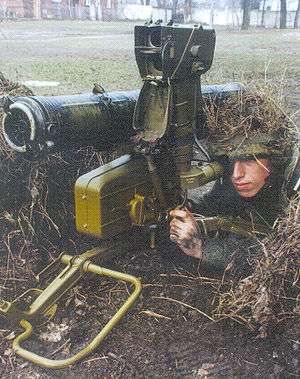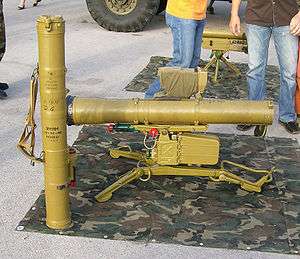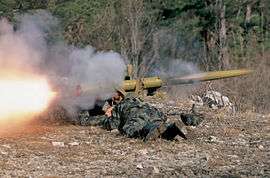9K111 Fagot
The 9K111 Fagot (Russian: Фагот; "bassoon") is a second-generation tube-launched SACLOS wire-guided anti-tank missile system of the Soviet Union for use from ground or vehicle mounts. The 9K111 Fagot missile system was developed by the Tula KBP Design Bureau for Instrument Building. "9M111" is the GRAU designation of the missile. Its NATO reporting name is AT-4 Spigot.
| 9K111 Fagot | |
|---|---|
 9K111 Fagot in Polish service | |
| Type | Anti-tank weapon |
| Place of origin | Soviet Union |
| Service history | |
| In service | 1970–present |
| Used by | See Operators |
| Wars | Vietnam War Soviet–Afghan War[1] War in Afghanistan Iran–Iraq War[2] Western Sahara War[3] 2008 South Ossetia war[4] War in Donbass Iraq War Syrian Civil War[5] Iraqi Civil War (2014–2017)[5] Yemeni Civil War (2015–present) Saudi-led intervention in Yemen Conflict in Najran, Jizan and Asir |
| Production history | |
| Designer | Tula Machinery Design Bureau (Tula KBP) |
| Designed | 1962 |
| Produced | 1970 |
| Variants | See Models |
| Specifications | |
| Mass | 12.5 kg (28 lb) (Missile weight) 22.5 kg (50 lb) (9P135 launching post)[6] |
| Length | 1,100 mm (3 ft 7 in) |
| Diameter | 120 mm (4.7 in) |
| Action | 400 mm versus RHA or 200 mm towards armour inclined at 60° |
| Rate of fire | 3 rds / min |
| Muzzle velocity | 80 m/s (180 mph; 290 km/h) at launch 186 m/s (420 mph; 670 km/h) in flight speed |
| Effective firing range | 70–2,500 m (230–8,200 ft) |
| Warhead | High Explosive Anti-Tank (HEAT) warhead |
| Warhead weight | 1.7 kg (3.7 lb) |
Guidance system | SACLOS wire-guided missile |
Development
The 9K111 Fagot was developed by the Tula Machinery Design Bureau (Tula KBP) and development began in 1962 with the aim of producing the next generation of SACLOS ATGMs for use in both the man portable role and the tank destroyer role. The 9K111 Fagot was developed alongside the 9M113 Konkurs; both missiles use similar technology, only differing in size, and can use the same launchers. The missile entered service in 1970.
History
The anti-tank platoon of a Soviet BTR equipped motor rifle battalion had two (sometimes three)[7] ATGM squads, each with two 9K111 Fagot teams. The team consisted of three men; the gunner carries the 9P135 launcher and tripod as a back pack, and the other two men each carry two launch tubes. The men also carry assault rifles, but do not carry an RPG, because unlike the earlier missiles there is only a small deadzone within which the missile cannot engage the target. Besides the four missiles carried by each team, each squad would normally have an extra eight missiles carried in their transport, usually a BTR. It can also be deployed from the BMP-1P, BMD-1P, BTR-D and UAZ-469.
North Korea was said to have acquired a number of the systems during the late 1980s until the 2000s from the USSR. These were subsequently reverse-engineered under the designation Bulsae-2.[8] Its use was first reported in 2014 in the ranks of the Izz ad-Din al-Qassam Brigades and the Al-Nasser Salah al-Deen Brigades.[9]
Description

The missile is stored and carried in a container/launch tube. It is fired from a 9P135 launcher post, a simple tripod. A 9S451 guidance box is fitted to the tripod with the missile sitting just above. The 9Sh119 sight is fitted to the left side (from the gunner's POV). The complete launcher system weighs 22.5 kg (50 lb). The gunner lays prone while firing. The system can engage moving targets travelling at less than 60 km/h (37 mph). The launcher post can traverse through 360 degrees horizontally, and +/− 20 degrees in elevation. The sight has a magnification of 10x and a 5 degree field of view. Up to three missiles a minute can be fired from a launcher post.
The system uses a gas generator to push the missile out of the launch tube, which exits from the rear of the launch tube in a manner similar to a recoilless rifle. The missile leaves the launch tube at 80 m/s (180 mph; 290 km/h), and is then quickly accelerated to 186 m/s (420 mph; 670 km/h) by its solid fuel motor. This initial high speed reduces the missile's deadzone, since it can be launched directly at the target, rather than in an upward arc.
The launcher tracks the position of an incandescent infrared bulb on the back of the missile relative to the target and transmits appropriate commands to the missile via a thin wire that trails behind the missile. The SACLOS guidance system has many benefits over MCLOS, with the accuracy of the system stated as 90% in some sources, though its performance is probably comparable to the TOW or the later SACLOS versions of the 9K11 Malyutka.
Models

Missile
- 9M111 Fagot (NATO: AT-4 Spigot and AT-4A Spigot A) Entered service in 1970. Maximum range 2,000 m (6,600 ft; 1.2 mi), minimum 70 m (230 ft). Warhead 400 mm versus RHA or 200 mm towards armour inclined at 60°.[10]
- 9M111-2 Fagot (NATO: AT-4B Spigot B) Slightly improved version.
- 9M111M Faktoriya/Faktoria[11] (Trading post) or Fagot-M (NATO: AT-4C Spigot C) Improved motor, longer guidance wire. Maximum range 2,500 m (8,200 ft; 1.6 mi), minimum 75 m (246 ft). Improved single HEAT warhead; penetration 400 mm versus RHA or 230 mm towards armour inclined at 60°[10][12][13] (some publications claimed 9M111M to have tandem HEAT warhead).
| [14] | 9M111/AT-4A | 9M111-2/AT-4B | 9M111M/AT-4C |
|---|---|---|---|
| Launch tube weight | 13 kg (29 lb) | 13 kg (29 lb) | 13.4 kg (30 lb) |
| Range | 75–2,000 m | 75–2,500 m | 75–2,500 m |
| Warhead | HEAT, 400 mm RHA penetration | HEAT, 460 mm RHA penetration | Tandem HEAT, 600 mm RHA penetration |
Launcher
- 9P135 22.5 kg (50 lb). Can only fire the 9M111 Fagot series.
- 9P135M Can fire the 9M111 Fagot (NATO: AT-4 Spigot) series as well as the 9M113 Konkurs (NATO: AT-5 Spandrel) series missiles.
- 9P135M1 Updated version of the 9P135.
- 9P135M2 Updated version of the 9P135.
- 9P135M3 Deployed in the early 1990s. Adds 13 kg (29 lb) TPVP thermal imaging night sight – range 2,500 m (8,200 ft; 1.6 mi) at night.
- 9S451M2 A launcher with a night sight featuring an anti-dazzle system has been developed.
Operators

Current operators















- Hamas - Known to use Bulsae-2s[18][19]

- Islamic State of Iraq and Levant – Unknown number captured[5]














- Free Syrian Army and other rebel groups – large numbers[11]




Former operators






See also
- List of Russian weaponry
References
- "Aleksandr Antonovich Lyakhovskiy Working Paper pp" (PDF). Woodrow Wilson Center for Public Policy. Archived from the original (PDF) on 2017-07-06. Retrieved 2017-07-15.
- "Archived copy". Archived from the original on 2018-05-10. Retrieved 2018-05-09.CS1 maint: archived copy as title (link)
- Ignacio Fuente Cobo; Fernando M. Mariño Menéndez (2006). El conflicto del Sahara occidental (PDF) (in Spanish). Ministerio de Defensa de España & Universidad Carlos III de Madrid. p. 117. ISBN 84-9781-253-0. Fuente & Mariño.
- "Записки с кавказской войны". Utro.ru. 2008-08-20. Archived from the original on 2017-08-17. Retrieved 2017-07-15.
- "Etat islamique: comment les djihadistes emploient les missiles antichars pour appuyer leurs offensives". France-Soir (in French). 4 May 2017. Archived from the original on 6 September 2018. Retrieved 6 September 2018.
- "AT-5 SPANDREL Anti-Tank Guided Missile". fas.org. Federation of American Scientists (FAS). Archived from the original on 2019-01-01. Retrieved 2018-12-15.
- Owen, Garry. "MRB Anti-Tank Platoon (APC)". Red Guards Index. Archived from the original on 12 January 2016. Retrieved 16 May 2014.
- "NORTH KOREA COUNTRY HANDBOOK : MARINE CORPS INTELLIGENCE ACTIVITY" (PDF). Fas.org. Archived (PDF) from the original on 2016-03-04. Retrieved 2017-07-15.
- "Archived copy". Archived from the original on 2017-09-20. Retrieved 2017-09-20.CS1 maint: archived copy as title (link)
- Maksim Sayenko. "Bronya »krylyatoy pyekhoty«" (Armour of "Winged infantry"). Tekhnika i Vooruzhenie no.02/2007, p. 39 (Russian)
- Jeremy Binnie, Neil Gibson (8 April 2016). "US arms shipment to Syrian rebels detailed". Jane's Defence Weekly. IHS. Archived from the original on 5 December 2016. Retrieved 3 December 2016.
- "ПТРК 9К111 "ФАГОТ"". Btvt.narod.ru. Archived from the original on 2012-03-27. Retrieved 2017-07-15.
- 9K111 Fagot Archived 2018-02-22 at the Wayback Machine - Weaponsystems.net
- "Trade Registers". Armstrade.sipri.org. Archived from the original on 2010-04-14. Retrieved 2017-07-15.
- "Armament of the Georgian Army". Georgian Army. Archived from the original on 2012-03-09. Retrieved 2007-06-25.
- Jeffrey Lewis. "Oryx Blog on DPRK Arms Exports". Archived from the original on 2014-12-29. Retrieved 2014-12-29.
- "Archived copy". Archived from the original on 2018-06-12. Retrieved 2018-07-31.CS1 maint: archived copy as title (link)
- Small Arms Survey (2012). "Blue Skies and Dark Clouds: Kazakhstan and Small Arms". Small Arms Survey 2012: Moving Targets. Cambridge University Press. p. 131. ISBN 978-0-521-19714-4. Archived from the original (PDF) on 2018-08-31. Retrieved 2018-08-30.
- "Archived copy". Archived from the original on 2018-07-12. Retrieved 2018-07-31.CS1 maint: archived copy as title (link)
- https://tass.com/defense/1073578
- http://www.armstrade.org/includes/periodics/news/2019/0815/101553900/detail.shtml
- "Bataille de Palmyre: les djihadistes de Daech infligent un revers cinglant à l'armée de Bachar al-Assad". France-Soir. 13 December 2016. Archived from the original on 4 September 2018. Retrieved 4 September 2018.
- "Archived copy". Archived from the original on 2018-01-15. Retrieved 2018-01-15.CS1 maint: archived copy as title (link)
Sources
- Hull, A.W., Markov, D.R., Zaloga, S.J. (1999). Soviet/Russian Armor and Artillery Design Practices 1945 to Present. Darlington Productions. ISBN 1-892848-01-5.